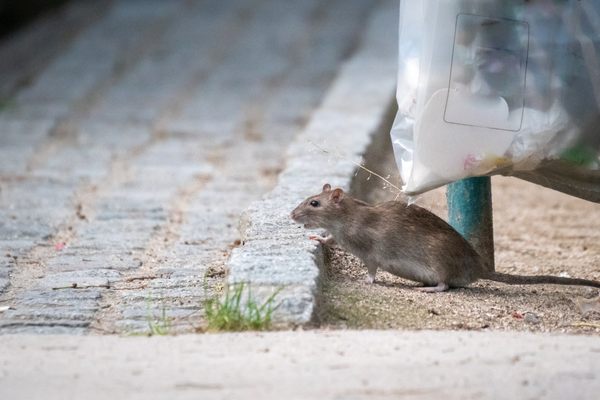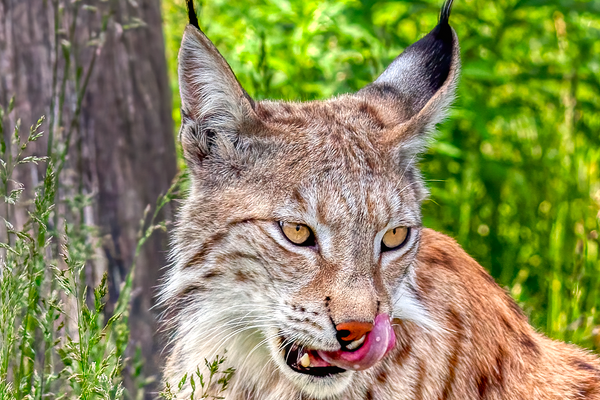City Cats Might Not Be the Rat-Control Option We Thought They Were
But they’re still bad news for birds.

The ability to hunt, kill, and eat rodents is a permanent part of the cat brand, right alongside aloofness and scratching up the couch.
Not so fast, says a team of researchers with a new study out today in Frontiers in Ecology and Evolution, which provides rare insight into the cat-rat dynamic in an urban environment. The team, led by Michael H. Parsons of Fordham University, has found that feral cats (Felis catus) are seemingly ineffective predators of city rats (Rattus spp.), despite the cats’ reputation as urban rat-control agents. The team studied a rat colony living in a waste management facility in Atlas Obscura’s own Greenpoint, Brooklyn, over a period of five months, between December 2017 and May 2018. In that time, the surrounding feral cats landed just three confirmed kills.
That’s not what Parsons expected, though he says he didn’t really expect anything. Parsons just wanted to study rats—common culprits in food contamination, disease spread, and gnawed-wire fires—but it wasn’t easy. Finding a site willing to host his research into “socially phenotyping” rats, effectively a cultural study of an animal almost universally seen as vermin, took more than a year of rejection. “I cried more than once,” he says. “Can I catch and release a rat on your property? There’s nothing good that can come out of that.” He was finally able to set up shop in the Greenpoint facility, where the dust falls so heavily that it “almost looks like it’s snowing inside the building,” in fall 2017, and began rat pheromone–based experiments in December.


The researchers think the pheromones and trapped rats attracted cats, and Parsons assumed that his research into rodent society would be doomed by the unwelcome intrusion. “This is just another headache,” he thought at the time, but he decided to lean in. “Let’s publish the headache.”
The team continued with their plan to trap rats and tag them with microchips, which helped the researchers track behavioral patterns over time and document the rats’ “individual life histories.” All told, they chipped roughly 60 rats, and observed at least five cats.
“Are the cats gonna be plucking rats, my microchipped, precious rats, that cost 30 to 50 dollars each?” Parsons asked himself. They didn’t have to change their observational setup much to find out. Rats exhibit “site fidelity,” or the tendency to walk the same pathways over and over again, so the team had installed just two cameras to follow them, pointed at the colony’s “rat runways”—one east-west, one north-south. The cameras were triggered by movement—rat, cat, or human—so the researchers could observe interspecies interaction. That interaction, it turned out, rarely involved a cat killing a rat.
Other findings from their five months of observation are just as telling, and they attribute the low rat death toll more to rodent caution than feline incompetence. “For every 1% increase in the number of cats on a given day,” the researchers write, “it is 100 times less likely that a rat will trigger a camera on that day.” In other words, when the cats were there, the rats made themselves scarce, by staying inside and—who knows, making more rats? And they were more likely to stay out of sight the next day, too. What’s more, as anyone who’s walked through a particularly infested block knows, the appearance of humans didn’t seem to influence the rats’ behavior at all.
Cats are often praised for taking care of rodent infestations and sometimes even deployed for that specific purpose. Since 2016, Chicago’s Tree House Humane Society has provided some 400 cats to willing caretakers with rodent problems, says the society’s Director of Operations Darlene Duggan. While it’s true that cat pheromones alone can inhibit rodent reproduction, Parsons is not yet convinced that the presence of cats meaningfully influences rat populations over time: The rats might just be hiding or, as Duggan admits, moving next door.
Parsons, in fact, would be “horrified” to see more cats introduced for this purpose. A 2017 study in Frontiers in Ecology and the Environment called Felis catus one of “the most ubiquitous and environmentally damaging invasive predators on Earth,” thanks to its role in the extinctions of at least 63 vertebrates all over the world. A 2013 study estimated that cats kill 2.4 billion birds annually in the United States alone. (Cats also become pretty prodigious disease carriers themselves.) For Parsons, the key to rat management is in waste management. With less trash lying around, especially overnight, the rats would effectively “control themselves,” he says.

The new research is suggestive, but not definitive, in part because Parsons didn’t have another site, such as one with less rat food on hand, which would depress reproduction and perhaps allow cats to make a real dent. Even then, however, city rats don’t make easy prey. They weigh on average more than 10 ounces, roughly ten times the weight of a mouse. “I don’t want to argue whether cats can control rats,” says Parsons. “What I want to say is cats take the easier meal.”
























Follow us on Twitter to get the latest on the world's hidden wonders.
Like us on Facebook to get the latest on the world's hidden wonders.
Follow us on Twitter Like us on Facebook